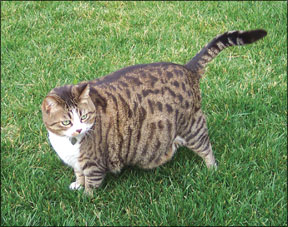Your cat Pinky has enjoyed good health for most of the eight years shes spent in your home. Lately, however, shes been undergoing some worrisome changes. Shes eating and drinking much more than she used to; shes recently begun to develop a potbelly; and shes become uncharacteristically lethargic. While such changes could be attributable at least in part to her advancing age, they are also signs that Pinky could be afflicted with a disorder called hyperadrenocorticism, otherwise known as Cushings disease. Bev Caldwell 288 According to Deb Zoran, DVM, PhD, an associate professor of medicine at Texas A&M Universitys College of Veterinary Medicine and Biological Sciences, this condition is extremely rare in cats – far less frequently diagnosed than it is in dogs. Nevertheless, cat owners should be aware of Cushings disease, its causes, the clinical signs associated with it and the treatment options available.
Important Hormones
Named after the American neurosurgeon who first described this condition in humans about a century ago, Cushings disease is a disorder of the adrenal glands, a pair of bean-shaped little structures situated just above the kidneys. Like other glands in the feline endocrine system, the adrenal glands manufacture and secrete potent chemicals (hormones) directly into the bloodstream that facilitate and regulate a host of bodily processes.
Among the dozens of hormones secreted by the adrenal glands are several glucocorticoids, chemicals that perform a wide variety of vital functions. None of the glucocorticoids is more important than a chemical called cortisol – a hormone involved in the metabolism of carbohydrates, fats and proteins, the maintenance of normal blood sugar levels, muscle development and many other functions related to tissue growth and repair.
In addition, cortisol is essential to an animals “fight-or-flight” response. In stressful situations, the adrenal glands rush additional cortisol into the bloodstream. This enables the release of stored energy in the body, which can then be used to cope with either a perceived threat or a true physical challenge, such as surgery or the onset of infection.
The amount of circulating cortisol is regulated by another component of the endocrine system – the pituitary gland, a minute oval structure located at the base of a cats brain. The pituitary gland controls the secretion of cortisol by sending a message to the adrenal gland via a hormone of its own, called adrenocorticotropic hormone (ACTH). In a normal animal, the pituitary ceases secreting ACTH when a proper level of cortisol has been secreted into the system.
Excess Cortisol
Since cortisol plays a role in countless bodily functions and cats therefore require a properly modulated flow of this hormone through their systems, an excess can have perilous consequences, such as a compromised ability to metabolize nutrients, diminished cardiovascular efficiency, reduced muscle strength and interference with normal blood-clotting function and the bodys ability to ward off infection.
A cat with Cushings disease may exhibit extreme fragility of the skin, which may rupture during routine handling, thus exposing the animal to infection. Such animals are also less able to heal efficiently following surgery or an injury. And due to the effects of chronic cortisol excess on blood-sugar metabolism, up to 90 percent of felines with Cushings disease also become diabetic. Most cats with Cushings disease are middle-aged or older, and the condition is far more common in females than in males.
Common Causes
According to Dr. Zoran, two types of cancer, either of which can cause the adrenal gland to secrete too much cortisol, are responsible for the majority of Cushings disease cases. The more common of the two cancers is a small, benign, slow-growing tumor in the pituitary gland. “Its so small,” Dr. Zoran says, “that it isnt pressing on anything, so it doesnt cause any neurologic problems for the animal. But it does cause excessive secretion of ACTH, which tells the adrenal glands to produce more cortisol. As a result, the adrenal gland hypertrophies – it gets larger, just like a muscle that gets a lot of exercise grows bigger.”
This type of condition – known as pituitary-dependent Cushings disease – is believed to account for as much as 80 percent of cases. The remaining 20 percent of cases are attributable to cancerous growths in one or both adrenal glands, which cause the gland to become enlarged and start producing an excessive amount of cortisol. In about 50 percent of cases, an adrenal-gland tumor will be benign; in the other 50 percent of cases, however, the tumor will be malignant and may spread to the lymph nodes or the liver and other vital organs.
Treatment Options
Diagnosis of Cushings disease will typically start with a complete blood count, blood chemistry panel, urinalysis and other standard tests. Additional procedures, such as measurement of the cortisol concentration in the blood and various types of imaging, especially ultrasound, may also be done to confirm a tentative diagnosis of the disease.
If Cushings disease is conclusively diagnosed, treatment may involve the use of drugs that selectively destroy the part of the adrenal gland that is producing too much cortisol. However, while such drugs are reasonably effective in treating dogs with this condition, they are known to be far less effective in treating affected cats.
Consequently, surgical treatment may be the sole option. Unfortunately, pituitary tumors are extremely difficult, if not impossible, to remove surgically. Thus, the removal of one or both adrenal glands is the current treatment of choice, although this is a complicated procedure requiring extensive postoperative management. Moreover, surgical removal will only work if the cancer has not spread to other parts of the body.
Given that the cancer has not metastasized, prognosis for long-term postoperative survival is quite good, although cats that have had their adrenal glands removed will need to be on medication for the remainder of their lives. Diabetic cats must have their blood chemistry, water consumption and urine output monitored frequently.. And all cats that have undergone surgery to remedy Cushings disease must undergo veterinary evaluation several times annually.



